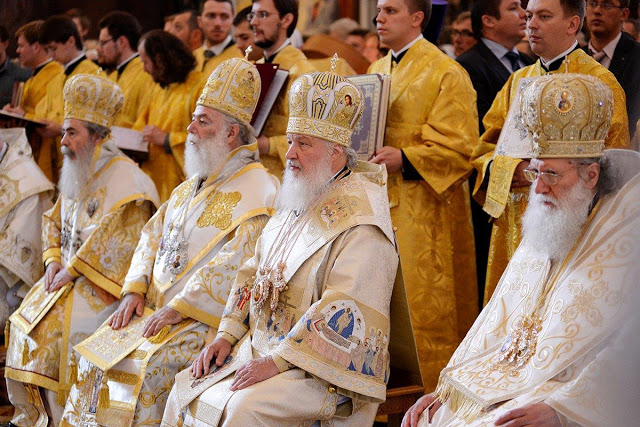The ancient Church consisted of four “orders”, all of which were necessary for proper governance of the Body of Christ. Laity, deacons, presbyters (priests), and bishops all play unique roles, which we find illustrated throughout the New Testament, particularly in Saint Paul’s First Letter to Timothy.
Let’s dive a little deeper into the Orthodox Church’s four holy orders.
Estimated reading time: 4 minutes
The Order of the Laity
Firstly, there is the order of the laity (Gr. laos). In Scripture, we see the laity also called “saints” (Romans 1:7; 2 Cor. 1:1; 1 Tim. 5:10), the “faithful” (Eph. 1:1); and “brethren” (Col. 1:2). The faithful are all the people of God, the royal Priesthood. Technically the term “laity” includes Clergy, though in our day the word usually refers to those in the Church who are not ordained. It is from among the laity that the other three orders emerge.
The easiest way to tell the difference between a lay person and a clergyman in the Orthodox Church is what they wear. Deacons, priests, and bishops often wear different types of vestments that distinguish them from the laity, and from each other.
The Order of the Deaconate
Next, we have the order of the deacons, sometimes called the Deaconate. This order is the lowest degree out of the three major (ordained) orders. Deacons, literally “servants,” are ordained to serve the Church and must meet high qualifications (1 Tim. 3:8-13). The Apostles were the first to take on the service tasks of deacons, and when the workload became too great they called for “seven men of good reputation, full of the Holy Spirit and wisdom, whom we may appoint over this business” (Acts 6:3). Besides serving the material needs of the people, deacons occupy a crucial role in the liturgical life of the Church. They will minister to the priest and bishop by:
- Assisting in the celebration of the mysteries of the Church
- Distributing the Eucharist in addition to (or in absence of) the priest
- Leading the people in the collective prayers
- Reading from the Scriptures during the divine services
- Keeping the decorum of the public worship, including calling people to attention at appropriate times
- Any tasks of the subdeacon or reader
- Other tasks related to Church life, with the blessing and direction of his priest or bishop.
The Order of the Presbyters
Thirdly is the order of the priests. The Presbyters (“priest” for short), or Elders, are visible throughout the New Testament. Their ministry from the start was to oversee, labor in the Word, and teach in the local congregations. Saint Paul “appointed elders in every church” (Acts 14:23) and later instructed his disciple, Titus, to do the same in Crete (Titus 1:5). In no way is the ordained Christian Priesthood a throwback to or a reenacting of the Old Testament Priesthood. Rather, the Orthodox priest is a minister of the New Covenant, which supersedes the Old Covenant. He is joined to Christ Who Is our High Priest “according to the order of Melchizedek” (Hebrews 5:6, 10).
The Order of the Episcopacy
The Bishop is the “overseer” of the congregation and clergy in a given area. Often the terms “bishop” and “elder” are interchangeable in the New Testament (Acts 20:17, 28), with the bishop being the leader of the elders. The qualifications for bishop in 1 Timothy 3:1-7 and Titus 1:7-9 underscore this role. Nevertheless, “bishop” is a specific office both in the New Testament and in the early Church. The Twelve were the first to hold this office (in Acts 1:20 “office” is literally translated “bishopric”) and they in turn consecrated other bishops to follow them. For example Timothy and Titus are clearly of a separate order from that of elder (see 1 Timothy 5:17-22; Titus 1:5). Early records show James was bishop of Jerusalem by A.D. 49 and functioned accordingly at the First Council there (Acts 15:13-22). Peter is on record as the first bishop of Antioch prior to A.D. 53, and later first bishop of Rome, where he was martyred about A.D. 65.
The Bishop’s authority is not over the Church per se, but within the Church. He serves as an icon of Jesus Christ, “the Shepherd and Overseer of your souls” (1 Peter 2:25).
All four orders have authority!
In the Orthodox Church, all four orders have authority, with the bishop as the center of unity. Church leadership does not consist of one or more of the orders functioning without the others. Instead, the Church is like a symphony orchestra, with Christ as the conductor. Many people falsely assume the bishop is the conductor, but he is not! Rather, he is part of that orchestra, too, a percussionist helping to keep everyone to tempo. In the True Faith, all members of the Body of Christ in their given offices work together as the dwelling place of the Holy Trinity.
Keep Reading: How To Greet An Orthodox Priest Or Bishop Properly

